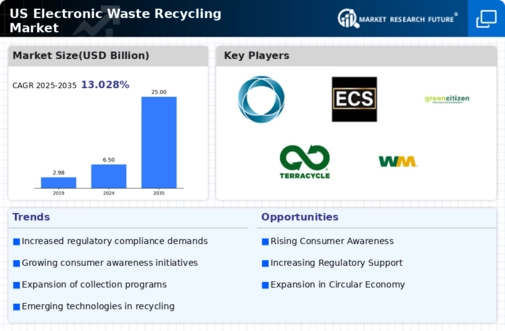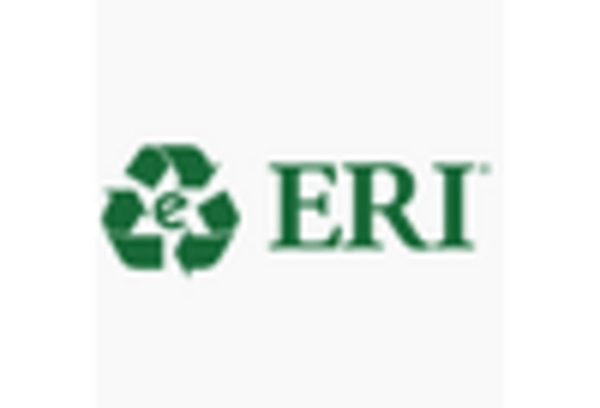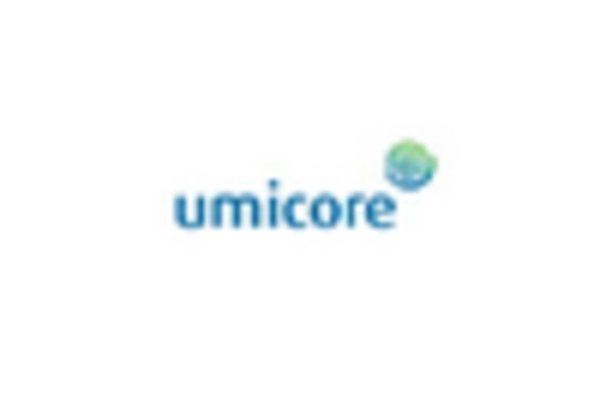Rising E-Waste Generation
The electronic waste-recycling market is witnessing a surge in e-waste generation., driven by the rapid advancement of technology and the increasing consumption of electronic devices. In the US, it is estimated that around 9.4 million tons of e-waste are produced annually, with projections indicating a potential increase of 20% by 2027. This growing volume of discarded electronics necessitates efficient recycling solutions to mitigate environmental impacts. As consumers replace devices more frequently, the demand for recycling services intensifies, prompting businesses to invest in sustainable practices. The rising e-waste generation not only highlights the need for effective recycling but also presents opportunities for innovation within the electronic waste-recycling market, as companies seek to develop new methods for processing and recovering valuable materials.
Enhanced Environmental Regulations
The electronic waste-recycling market is significantly influenced by the implementation of enhanced environmental regulations in the US. Legislative measures aimed at reducing the environmental impact of e-waste are becoming increasingly stringent. For instance, states like California and New York have enacted laws mandating proper disposal and recycling of electronic devices. These regulations often require manufacturers to take responsibility for the end-of-life management of their products, thereby creating a more structured recycling ecosystem. As compliance becomes essential, businesses in the electronic waste-recycling market are compelled to adapt their operations to meet these legal requirements. This shift not only fosters a more sustainable approach to e-waste management but also encourages innovation in recycling technologies and processes.
Increased Public Awareness and Education
The electronic waste-recycling market is experiencing a shift due to increased public awareness and education regarding the importance of responsible e-waste disposal. Campaigns aimed at informing consumers about the environmental impacts of e-waste and the benefits of recycling are gaining traction across the US. Research indicates that approximately 60% of consumers are now aware of e-waste recycling options available to them. This heightened awareness is leading to greater participation in recycling programs and initiatives, ultimately driving demand for electronic waste-recycling services. As educational efforts continue to expand, the electronic waste-recycling market is likely to benefit from a more informed public that actively seeks out sustainable disposal methods for their electronic devices.
Growing Corporate Sustainability Initiatives
The electronic waste-recycling market is witnessing a notable increase in corporate sustainability initiatives as businesses recognize the importance of responsible e-waste management. Many companies are now adopting comprehensive recycling programs to minimize their environmental footprint and enhance their corporate social responsibility profiles. According to recent surveys, approximately 70% of US corporations have implemented or are planning to implement e-waste recycling strategies. This trend is driven by both consumer demand for sustainable practices and the potential for cost savings through resource recovery. As corporations prioritize sustainability, the electronic waste-recycling market is likely to expand, with more partnerships forming between businesses and recycling firms to facilitate effective e-waste disposal and recycling.
Technological Innovations in Recycling Processes
The electronic waste-recycling market is benefiting from technological innovations that enhance recycling processes and improve material recovery rates. Advanced techniques such as automated sorting, hydrometallurgical processes, and artificial intelligence are being integrated into recycling facilities, allowing for more efficient processing of e-waste. These innovations not only increase the volume of materials that can be recovered but also reduce the environmental impact associated with traditional recycling methods. For instance, the adoption of AI-driven sorting systems can improve the accuracy of material separation, leading to higher quality recycled materials. As technology continues to evolve, Further advancements are expected in the electronic waste-recycling market that could revolutionize the way e-waste is processed and managed..
















Leave a Comment